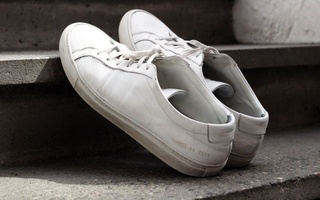The 20s had flapper dresses that hung instead of clung—the better to celebrate female liberation, my dear.
The 30s had glamorous getups of gold, gaudy glitter—the better to escape the Great Depression woes, my dear.
The hippies of the 60s sported peace signs and flowers; in the 90s, Calvin Klein and Madonna heralded in a decade of shocking, skin-revealing Minimalism.
But the question is, what have we got?
In the game of Name-that-Fashion-Decade, most players stop short at the year 2000. The development of style throughout the twentieth century was largely an exercise in pushing the envelope the contained the rules of dress so that we might better disclose our inner selves through clothes. But with Lady GaGa wearing raw meat on the red carpet and Miley Cyrus running around in pasties and nothing else, it seems like the envelope has burst. What’s left to reveal if we’re already basically naked?
Interestingly enough, my friends that study other types of art—music, fine, and even writing—feel as if their artistic fields are up against a similar conceptual wall. Namely, that it’s hard to shock people anymore.
A concrete example of this can be found in the fine arts, where we’ve already deemed work as “Post-Modern.” It seems like artists are painting themselves into a semantic corner that mirrors a more conceptual one happening in all aesthetic fields. Have we innovated as much as we can? What will we call the 2020s? Post-Post-Post-Modernism?
More importantly what will it look like? There is a tendency to dismissively label the aesthetic of our generation a referential mash-up of the preceding century’s trends. And I can see why. Most garments—from patterned bell-bottoms to crocheted underwear—have been worn before. At this point, virtually any silhouette, fabric, or color combination you put on your body has a rich sartorial history.
But that’s not to say that we millennials don’t have an aesthetic of our own. In fact, I think we have two. These aren’t defined by the form of our clothes, but by their functions.
This all became clear to me one night last week, when I attended a fancy party wearing a pair of dressy heels only to see another girl sporting a pair of sneakers. She looked great—blasé in the best way possible—and not at all out of place despite her classically casual choice in footwear. These days, tricked-out kicks are as commonplace as freshmen in Annenberg.
Herein lies what I’m going to call Trend #1: “When Hyper-Superficiality Desecrates Function.”
The sneakers of today are a far cry from their original predecessors, which were invented in the late 18th century as nothing more than rubber-soled kicks so crude that the left and right shoe looked exactly the same. Initially created with the intent to fabricate a practical, comfortable shoe, sneakers were considered to be distinctly un-fashionable until the mid twentieth century, when the movie “Rebel Without a Cause” featured celebrity-of-the-moment James Dean wearing Ked sneakers outside of their usual sporty context.
Since then, we’ve taken the sneaker-as-dress-shoe and embellished it to death. In true twenty-first century, ultra-consumerist fashion, there exists an entire market of sneakers that are encrusted with Swarovski crystals, made of quality suede, or perched upon platform heels. Celebrities like A$AP Rocky and DJ Khaled own extensive sneaker collections, made up of shoes from designers like Jeremy Scott and Christian Louboutin, who sell their sneaks for thousands of dollars.
In other words, these are purely aesthetic sneakers, so bombastic in their embellishment that they shortchange usefulness for superficiality. The design and construction of most of these shoes render them completely useless for sports.
But at the same time, we’ve got a vastly different Trend #2 operating, which I’m going to call “When Technology Saves the Day.”
Read more in Opinion
Recognizing HistoryRecommended Articles
-
 J. Lin Signs Shoe Deal With Nike?
J. Lin Signs Shoe Deal With Nike? -
These Boots Are Made for Walking…Come Rain or Shine“Sorry, I was just admiring your shoes. I really like them. Where’d you get them?” she said. “Oh, thanks so ...
-
Men's Basketball Living La Bella VitaThe Harvard Men’s Basketball team is traveling to Italy in mid-August for some summer competition. The Crimson will be playing ...
-
Lin '10 Signs Endorsement Deal With Adidas
-
 Sorry Mom, I Spent $350 on Some Dumb Sneakers
Sorry Mom, I Spent $350 on Some Dumb Sneakers













